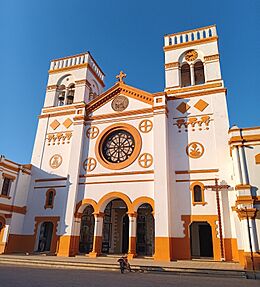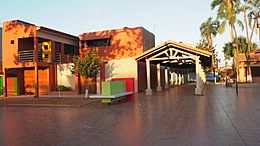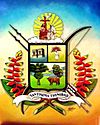Trinidad, Beni facts for kids
Quick facts for kids
La Santísima Trinidad
Trinidad
|
|||
|---|---|---|---|
|
City
|
|||
|
Scenes of Trinidad
|
|||
|
|||
| Motto(s):
"Green Trinidad"
|
|||
| Country | Bolivia | ||
| Department | Beni | ||
| Province | Cercado | ||
| Founded | 1686 | ||
| Area | |||
| • City | 27 km2 (10 sq mi) | ||
| Elevation | 130 m (427 ft) | ||
| Population
(2020 Census)
|
|||
| • Urban | 130,657 | ||
| Time zone | UTC-4 | ||
| Area code(s) | +591 346 | ||
| Climate | Am | ||
| Website | Official website: http://www.trinidad.gob.bo/ | ||
Trinidad, officially known as La Santísima Trinidad (which means "The Most Holy Trinity"), is an important city in Bolivia. It is the capital city of the Beni region. About 130,000 people live here.
Even though Trinidad used to be a smaller city, it has become a key place for Bolivia's cattle farming industry. The city has seen good economic growth recently. It also has a high HDI score, which means people there generally have a good quality of life.
Trinidad is located near the edge of the Amazon rainforest. It gets a lot of rain, like a rainforest. The Mamoré River connects it to the larger Amazon River system. The year is split into wet and dry seasons, which is common in this part of the Amazon.
This city is growing and is very important for the local economy in northern Bolivia, especially for the area north of Santa Cruz de la Sierra. The Bolivian Navy also has a base here.
Contents
History of Trinidad
The city of Trinidad was first started in 1686 by a priest named Father Cipriano Barace. In 1769, the town had to move to its current spot. This was because the original location, which was right on the Mamoré River, often flooded and caused diseases. The new location is about 9 miles away. Trinidad is located in the Cercado Province, which is one of Beni's eight provinces.
Languages Spoken in Trinidad
The main language spoken by most people in Trinidad is a type of Spanish called Camba Spanish. It's like a common language that everyone uses. There's also an important local language called Trinitário. This language is a dialect of the Moxo group, spoken by the native people of the area.
City Infrastructure
One interesting thing about Trinidad is its open drains. These are like small canals that go around every block of buildings. They are connected by covered ditches that lead to the local river. These drains are very important because the city gets a lot of heavy rain from December to May. They help prevent flooding in the streets.
Tourism and Attractions
Trinidad is surrounded by many rivers, lakes, and lagoons. You can take fun river tours and find restaurants and resorts around the main lagoons.
Trinidad was also one of the first five towns started by Jesuit missionaries. These towns are now part of a special tour called the Misiones tour. This tour includes visits to other towns like San Javier, Loreto, San Pedro, and San Ignacio de Moxos. Both Trinidad and San Ignacio de Moxos host the International Baroque Music Festival every two years.
Climate in Trinidad
Trinidad is located at the southern edge of the Amazon basin, in an area called the Llanos de Moxos. This means it is hot and humid for most of the year. The region has many forests and large rivers that flow into the Amazon.
Like many cities in Bolivia, Trinidad is built around a main square with a large Catholic cathedral in the middle. Trinidad started as a small Jesuit town. Its original church was rebuilt in 1923. However, many old religious items, paintings, and statues are still kept in the cathedral today.
Trinidad has a tropical monsoon climate (Am). This means it has a long rainy season and a short dry season. The city gets a lot of rain, but it's clearly divided between wet and dry times of the year. Trinidad is actually the wettest capital city in Bolivia's departments. It gets over 1,400 millimetres or 55 inches of rain each year. This is much more than the capital city of La Paz, which gets about 600 millimetres or 24 inches.
| Climate data for Trinidad (Teniente Jorge Henrich Arauz Airport), elevation 156 m (512 ft) | |||||||||||||
|---|---|---|---|---|---|---|---|---|---|---|---|---|---|
| Month | Jan | Feb | Mar | Apr | May | Jun | Jul | Aug | Sep | Oct | Nov | Dec | Year |
| Record high °C (°F) | 40.3 (104.5) |
39.8 (103.6) |
36.2 (97.2) |
36.7 (98.1) |
35.5 (95.9) |
36.0 (96.8) |
37.2 (99.0) |
39.4 (102.9) |
43.2 (109.8) |
40.2 (104.4) |
40.0 (104.0) |
41.2 (106.2) |
43.2 (109.8) |
| Mean daily maximum °C (°F) | 31.2 (88.2) |
30.9 (87.6) |
31.2 (88.2) |
30.7 (87.3) |
29.4 (84.9) |
28.7 (83.7) |
29.4 (84.9) |
31.2 (88.2) |
32.4 (90.3) |
32.8 (91.0) |
32.1 (89.8) |
31.5 (88.7) |
31.0 (87.7) |
| Daily mean °C (°F) | 26.8 (80.2) |
26.8 (80.2) |
26.8 (80.2) |
26.0 (78.8) |
24.3 (75.7) |
23.0 (73.4) |
22.8 (73.0) |
24.2 (75.6) |
25.8 (78.4) |
26.9 (80.4) |
26.9 (80.4) |
26.8 (80.2) |
25.6 (78.0) |
| Mean daily minimum °C (°F) | 22.5 (72.5) |
22.6 (72.7) |
22.5 (72.5) |
21.3 (70.3) |
19.1 (66.4) |
17.3 (63.1) |
16.2 (61.2) |
17.1 (62.8) |
19.1 (66.4) |
21.0 (69.8) |
21.6 (70.9) |
22.2 (72.0) |
20.2 (68.4) |
| Record low °C (°F) | 14.8 (58.6) |
15.5 (59.9) |
13.0 (55.4) |
10.9 (51.6) |
7.0 (44.6) |
4.0 (39.2) |
2.0 (35.6) |
6.2 (43.2) |
9.0 (48.2) |
11.3 (52.3) |
10.1 (50.2) |
11.0 (51.8) |
2.0 (35.6) |
| Average precipitation mm (inches) | 308.0 (12.13) |
255.8 (10.07) |
221.3 (8.71) |
121.5 (4.78) |
98.4 (3.87) |
51.2 (2.02) |
40.2 (1.58) |
38.4 (1.51) |
92.1 (3.63) |
137.8 (5.43) |
197.5 (7.78) |
259.1 (10.20) |
1,821.3 (71.71) |
| Average precipitation days | 16.6 | 15.0 | 13.2 | 8.8 | 7.5 | 4.8 | 3.5 | 3.4 | 5.7 | 8.7 | 11.2 | 15.1 | 113.5 |
| Average relative humidity (%) | 79.6 | 80.2 | 78.6 | 76.5 | 76.1 | 74.9 | 69.8 | 64.9 | 65.6 | 69.8 | 73.8 | 77.9 | 74.0 |
| Source: Servicio Nacional de Meteorología e Hidrología de Bolivia | |||||||||||||
Museums and Wildlife
Trinidad has two special museums you might enjoy.
- The Museo Itícola (Fish Fauna Museum) is the third largest of its kind in South America. It has over 400 types of fish found in the local lakes and lagoons. You can see tiny fish, piranhas, and even a preserved pink river dolphin! It's located on the UAB University campus.
- The Kenneth Lee Ethno-Archeological Museum is another great place to visit. Here, you can see old pottery, tools, fabrics, and other items used by the ancient Moxos culture.
If you like birds, the very rare blue-throated macaw (Ara glaucogularis) lives in the countryside around Trinidad. You can arrange trips to see these beautiful birds.
Transportation in Trinidad
The city has an airport called Teniente Jorge Henrich Arauz.
- Airport Codes: TDD, SLTR
- Location: Lat: 14° 48' 0" S, Lon: 64° 46' 0" W
- Altitude: 509 feet (155 meters) above sea level
Gallery
Notable Person
- Asunta Limpias de Parada (1915–1995), a famous composer, writer, singer, and pianist from Trinidad.
See also
 In Spanish: Trinidad (Bolivia) para niños
In Spanish: Trinidad (Bolivia) para niños














